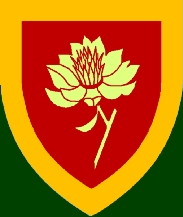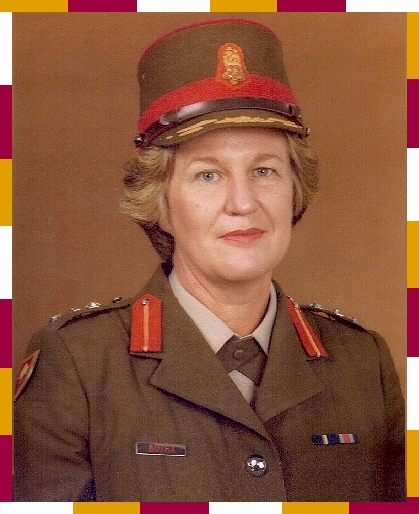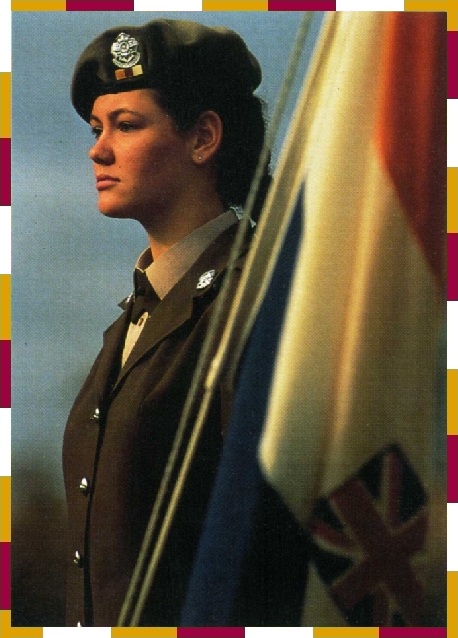|
History of the South African Women's Army College
During most of the pioneering years of South Africa's history there have been times when women have been compelled to shoulder a rifle and fight side by side with their men. In the Great Trek era women faced precisely the same perils, endured as much, suffered as much on the trek road.In the South African War, as recorded in prints of the time, women occasionally fought, both for the Boers and for the British. And in both world wars women saw active service with their male colleagues.
In South Africa the present annual intake of females to all four arms of the SADF is in the region of a thousand. In 1979 the first batch of 43 matriculated young women started training as national service volunteers with the South African Medical Service. It is hoped to increase the intake to 500 a year. The women join for a year, but the SAMS expect that many will stay on and become part of the Permanent Force. During the first eight weeks the girls undergo much the same basic training as their male counterparts including musketry, fieldcraft, map-reading, parade-ground work and PT. Afterwards follows ten weeks instruction in advanced first aid, military hygiene and pharmacy. Then they are posted to military hospitals where they serve as nurses, assistants to doctors, and as clerks or veterinary auxilaries.
The major centre for training women is the Army's Women's College in George (founded in 1971). The emphasis has been on civil defence techniques as well as the basic military skills and the more specific officer training courses. Five hundred women enrol each year.
In all services the women are taking the jobs previously held by men, who are thus released for combat roles. In the air force, for example, women are replacing men as air traffic controllers. The air force also has a large corps of draughtswomen. In 1978, the first five women qualified as instructors in the air force. A year earlier, SA's first female flying unit, 114 Commando Squadron for women, was set up. The squadron, based at Lanseria Airport near Johannesburg, comprises 20 pilots and five navigators. Its main peacetime functions are casevacs and flying senior SADF officers around the country on official duties.
Women first signed up for the navy during the Second World War when the South African Women's Auxiliary Naval Service (SWANS) was established. For nearly 25 years after the war the navy reverted to its traditional all-male status. But in the early 'seventies women were again taken on board. All women who join the PF staff of the navy first attend the basic training course at SAS Saldanha. In both classroom and in practice they get used to parade grounds, rigging, weapons, ship routine and the general norms of seamanship (or seawomanship). Once they pass out they can be appointed to administrative positions or to technical posts. Some are trained to operate the computers and the highly complex equipment at Silvermine.
Although the women's role in the SADF is expanding and is considered very useful, a number of questions inevitably arise. Two of the most common are the issues of conscription and combat roles.
Should SA conscript its women? In Rhodesia, despite the small white population and the severe manpower shortages, women were never conscripted although it was often suggested. However, a very high percentage of women did volunteer for the armed forces, the police and civil defence as well as such organisations as the WVS etc., which organised canteens and other comforts for the troops. In addition, many farmers' wives fought in the front line literally. With the massive pressure of male call-ups, women filled important roles in commerce and industry. Israeli women are conscripted, although the generous exemption rules, especially on religious grounds, mean that only 50 per cent of potential female conscriptees actually serve. Israeli women spend 24 months on duty and they are also liable for reserve duties up to the age of 34. If the threat against SA mounts to the same levels Israel faced in 1973 then perhaps Pretoria may also decide that the fairer sex should be made to don uniforms.
And combat? In China, where there is hardly a manpower shortage, the air force has a squadron of female fighter pilots. In America, some Women's Libbers argue that not only should women be included if the draft is renewed but also they should have combat status. Why should women in uniform be second-class soldiers, especially when promotion often depends on combat-related opportunities? Certainly, by all accounts, women have proved to be very capable. They have been placed top of their classes at the navy, air force and Marine officer schools, qualified for the crack army sharpshooter teams and gained places in the prestigious White House guard of honour. They also drink less, commit fewer drug offences, go AWOL less often and generally present fewer disciplinary problems. Moreover, in many jobs in the services intellect has replaced brawn. After all, how much muscle does it take to launch an ICBM?
The old image is out. Many highly intelligent, well adjusted women join the American armed forces for good career prospects. They insist on being given the experience necessary for promotion even if it is near the potential firing line.
Of course there are problems of all sorts in trying to aim for a military machine which is completely free of sexual discrimination. Soldiers will always be soldiers, especially if they are men. Fraternisation is a problem. (Handholding — between male and female — can result in a 400 dollar fine on some US ships.). And women also get pregnant. A growing problem in the US forces is the issue of one parent families — over 18 000 cases in the army, for example. Some women soldiers based overseas have missed manoeuvres because they couldn't find baby-sitters!
For the moment at least, it doesn't look as though the SADF will establish a 'corps of babysitters'. For South African women, volunteers are in and combat roles are out. But equal pay... ?
Women are again filling a major place in the S.A. Army. Although in a non-combatant role, women in uniform do duty at virtually every Army installation. The principal training centre, the S.A. Army Women's College at George, was founded in 1971 as a civil defence college. Originally the focus of training was on civil relief work, but basic military instruction for the women volunteers was not ignored.
Today the emphasis is on groundwork for advanced training to prepare the young graduates for posts in the Permanent Force as air traffic controllers, telecommunications, computer, radio and radar operators and a host of other skilled and highly technical jobs. The skills of the soldier are not forgotten, however. A major part of the course consists of instruction in small arms drill, parade-ground work and physical training. The College was awarded the freedom of the City of George in 1981. |


